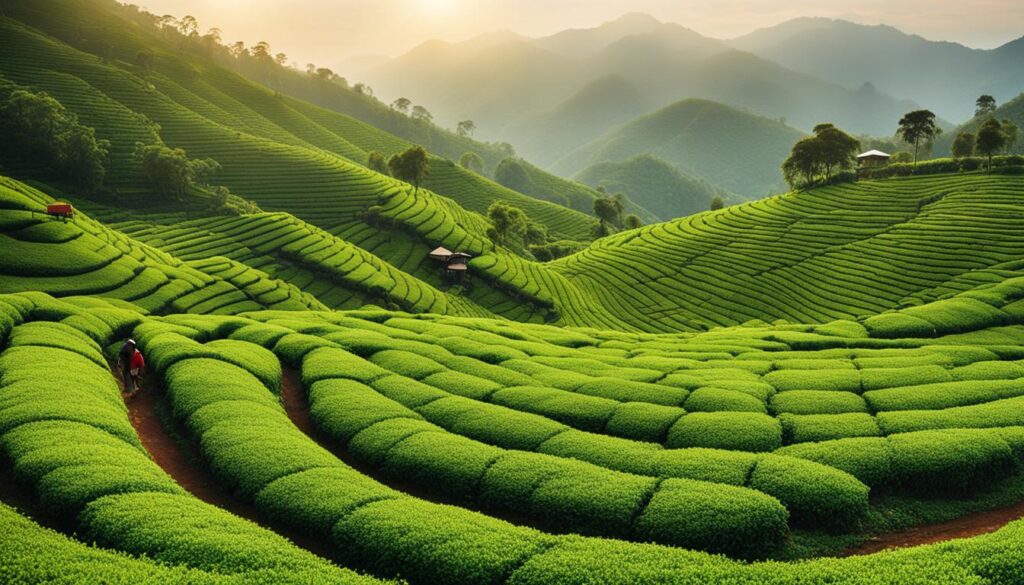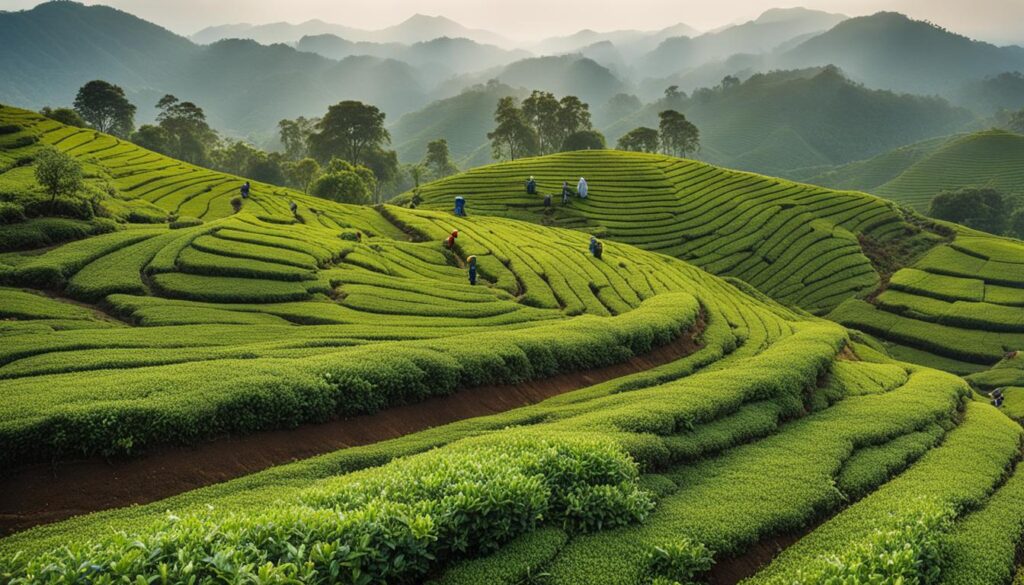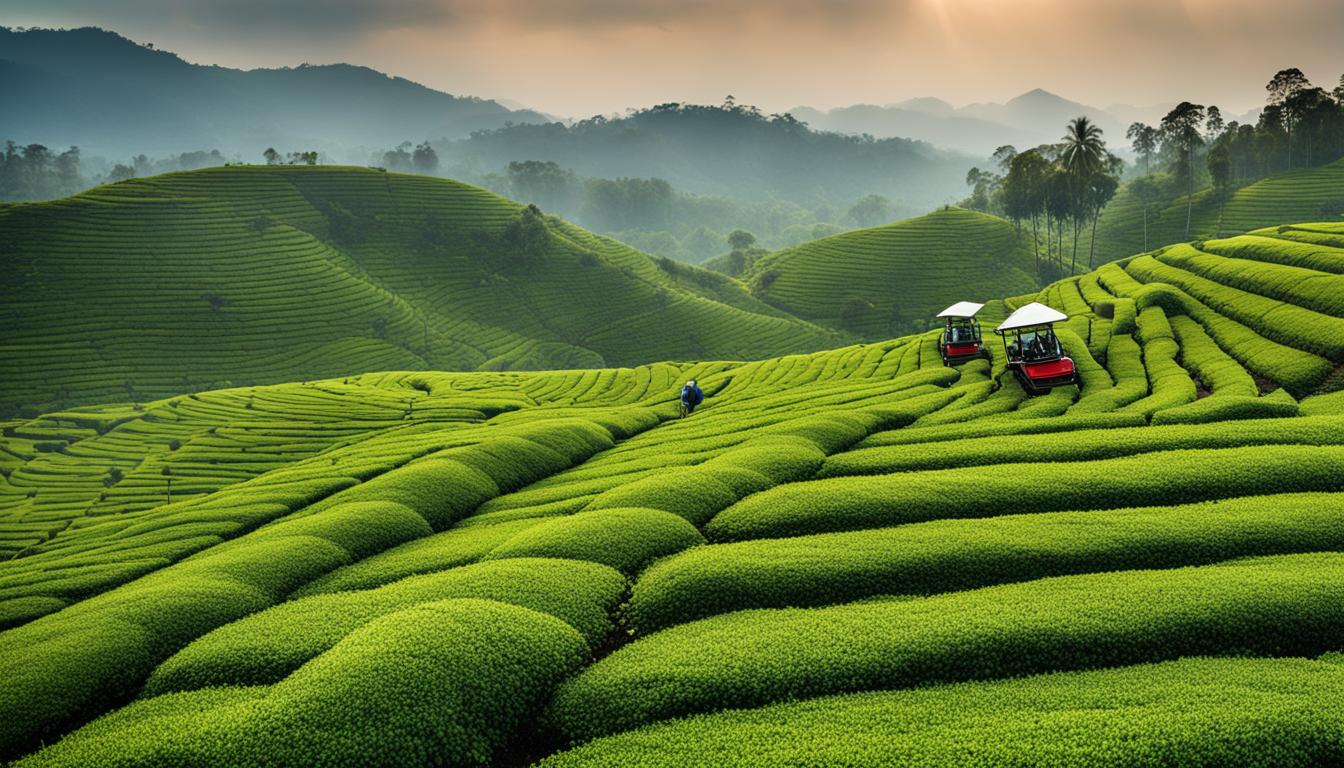Greetings tea enthusiasts! Today, we embark on a journey through the fascinating world of modern tea harvesting techniques. Join us as we explore the advancements in tea harvesting technology and delve into the efficiency of these modern methods. Prepare to be amazed by the innovations that have revolutionized the tea industry!
Key Takeaways:
- Modern tea harvesting techniques have brought about increased efficiency and improved quality control.
- Advancements in technology, such as automated tea harvesting machines, have made the process faster and more precise.
- These techniques have made it easier for farmers to produce high-quality tea.
- The selection of the harvesting method should consider factors such as desired flavor profiles, labor availability, and environmental impact.
- Modern tea farm management practices play a vital role in ensuring the success and sustainability of tea production.
Understanding Tea Harvesting
Tea harvesting is a delicate process that involves picking tea leaves from the tea plant, Camellia sinensis. The flavor of tea can be influenced by various factors, including the part of the plant from which the leaves are harvested and the timing of the harvest. For instance, gyokuro tea, known for its sweet flavor, is made from the top three leaves of the tea plant. These leaves are picked because they have the highest nutrient content and offer the best taste.
Tea can be harvested multiple times throughout the year, but the first harvest is considered the most desirable for producing premium-quality teas. Subsequent harvests may result in slightly lower quality leaves. The skill and technique employed in picking the tea leaves significantly impact the flavor and quality of the final product. Farmers must carefully consider these factors to produce the best tea possible.

Tea harvesting involves precision and attention to detail. The technique used and the part of the tea plant from which the leaves are picked can greatly influence the flavor of the tea.
Understanding the nuances of tea harvesting is essential for tea producers and enthusiasts alike. It allows them to appreciate the influence of different factors on the flavor profile of the tea. By selecting the right leaves at the right time, farmers can achieve the desired taste and aroma in their teas.
Traditional and Modern Tea Harvesting Techniques
In the world of tea harvesting, both traditional and modern techniques play a significant role. Traditional methods, such as hand-picking tea, have been practiced for centuries, while modern advancements have introduced mechanization to the process. Let’s explore the characteristics and differences between these two approaches.
Hand-picking Tea
The art of hand-picking tea leaves requires expertise and precision. Experienced tea pickers carefully select only the highest-quality leaves, ensuring optimal flavor and aroma. This method allows for greater control over leaf selection, contributing to the production of premium-quality teas.

However, hand-picking tea is a labor-intensive process that relies heavily on human resources. It can be time-consuming and may not be feasible for larger tea gardens. Despite these challenges, many tea connoisseurs appreciate the dedication and skill involved in hand-picked teas, valuing their unique characteristics.
Mechanical Tea Harvester
In contrast, modern tea harvesting techniques have introduced mechanization through the use of automated tea harvesting machines, like the mechanical tea harvester. These machines are designed to increase efficiency and productivity, making it possible to cover larger areas of tea gardens in a shorter time.
While mechanical tea harvesters offer higher productivity, they may not provide the same level of precision as hand-picking. Leaf quality can be affected due to the inability of machines to replicate the discernment of human tea pickers. Additionally, the use of machinery can lead to soil compaction and environmental impact, which are important considerations for sustainable tea production.
It’s important to note that the selection of tea harvesting method depends on various factors, such as the desired flavor profile, labor availability, and environmental impact. Finding the right balance between traditional and modern techniques is key to producing high-quality teas while ensuring the sustainability of tea farming.
Pros and Cons of Modern Tea Harvesting Techniques
Modern tea harvesting techniques offer numerous benefits that have revolutionized the industry. By incorporating advanced technology and precision agriculture methods, tea farmers can enhance efficiency, productivity, and sustainability in their harvest. However, it is important to consider both the advantages and drawbacks of these modern techniques.
Benefits of Modern Tea Harvesting
One of the key advantages of modern tea harvesting techniques is the increased efficiency they bring to the process. Automated tea harvesting machines significantly reduce the labor required for hand-picking, saving time and resources. This not only improves productivity but also allows farmers to cover larger areas of tea gardens in a shorter period.
Precision agriculture plays a crucial role in modern tea harvesting. Through the use of mechanized harvesters, farmers can optimize resource allocation and ensure optimal growth conditions for tea plants. This not only improves the overall health and yield of the tea plants but also minimizes the risk of crop losses.
Furthermore, modern tea harvesting techniques promote sustainability by reducing the time and effort required for harvest. By minimizing manual labor, these techniques help conserve energy and resources. This is especially important in today’s environmentally conscious world, as it allows tea farmers to adopt more sustainable practices and reduce their carbon footprint.
Drawbacks of Modern Tea Harvesting
While modern tea harvesting techniques offer significant benefits, there are also some drawbacks to consider. Mechanized harvesters may not provide the same level of precision as hand-picking, potentially affecting the quality of the tea leaves. Hand-picking allows for greater control over leaf selection, ensuring only the highest-quality leaves are chosen.
Additionally, the use of machinery in tea harvesting can lead to soil compaction and environmental impact. Mechanical tea harvesters are heavier than human workers, which can cause the soil to become compacted over time. This reduces the soil’s ability to retain water and nutrients, potentially affecting the long-term health of tea plants and the sustainability of tea farms.
It is essential for tea farmers to carefully consider the pros and cons of modern tea harvesting techniques, taking into account factors such as desired leaf quality, labor availability, and environmental impact. Striking a balance between efficiency, quality, and sustainability is crucial for the long-term success of tea production.
Conclusion
As we conclude our exploration of modern tea harvesting techniques, we can’t help but acknowledge the tremendous impact they have had on the tea industry. The integration of technology and automation has allowed farmers to optimize their harvests and enhance the overall quality of their teas.
Effective modern tea farm management is key to success in this ever-evolving industry. Conducting a cost analysis of different harvesting techniques can help farmers make informed decisions that maximize efficiency and minimize expenses. By prioritizing quality control throughout the production process, from harvest to packaging, we can ensure that only the finest teas reach consumers.
However, it is important to approach modern tea harvesting techniques with careful consideration. While the benefits are undeniable, factors such as the desired flavor profile, availability of labor, and potential environmental impact should be taken into account. By striking a balance between tradition and innovation, we can continue to deliver exceptional teas while preserving the essence of this ancient craft.
Join Us on the Journey
Join us as we embrace the exciting prospects that lie ahead in modern tea farm management. By staying informed about the latest advancements, analyzing costs, and prioritizing quality control, we can pave the way for a sustainable and prosperous future in the art of tea production. Together, let’s raise our cups to the remarkable journey of modern tea harvesting!
FAQ
What is tea harvesting?
Tea harvesting is the process of picking tea leaves from the tea plant, which greatly influences the flavor and quality of the final tea.
How does tea harvesting affect the flavor of tea?
The timing, method, and part of the tea plant from which the leaves are picked all play a role in the taste and aroma of the tea.
What are modern tea harvesting techniques?
Modern tea harvesting techniques involve the use of automated tea harvesting machines and mechanized tools to increase efficiency and improve quality control.
What are the advantages of modern tea harvesting?
Modern tea harvesting techniques increase efficiency and productivity, reduce labor requirements, minimize human error, and promote sustainability.
What are the drawbacks of modern tea harvesting?
Mechanized harvesters may not provide the same level of precision as hand-picking, and the use of machinery may lead to soil compaction and environmental impact.
How can modern tea harvesting techniques revolutionize the tea industry?
By incorporating technology and automation, modern tea harvesting techniques optimize the harvest and improve the overall quality of tea, while also promoting innovation and exceptional consumer experiences.





